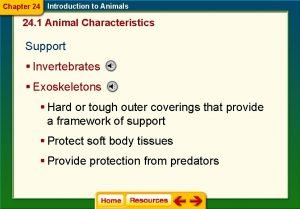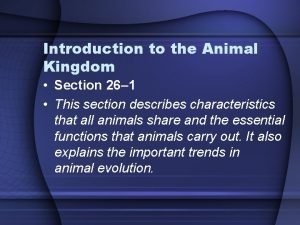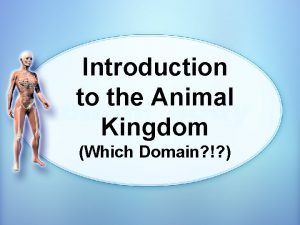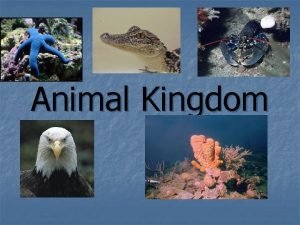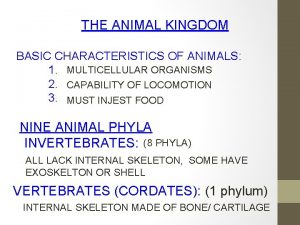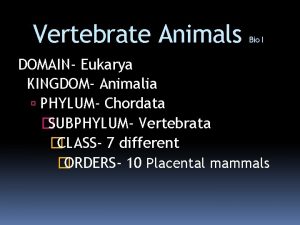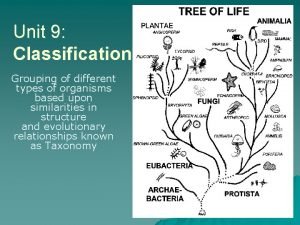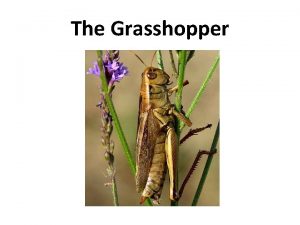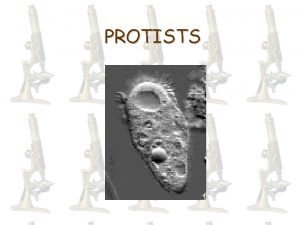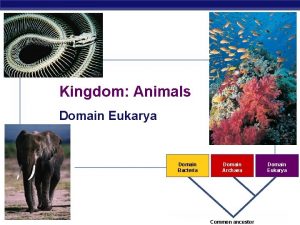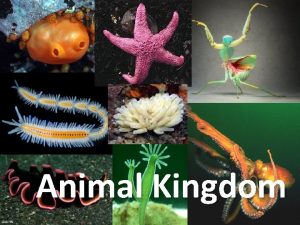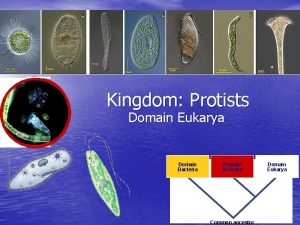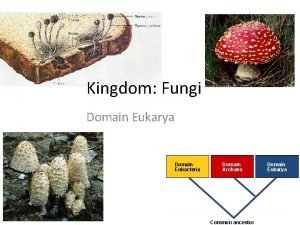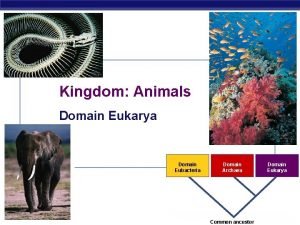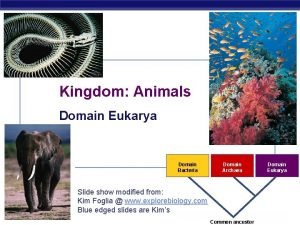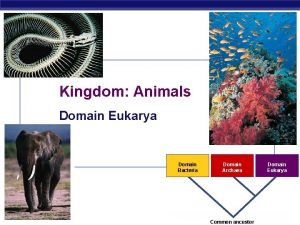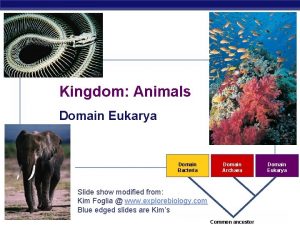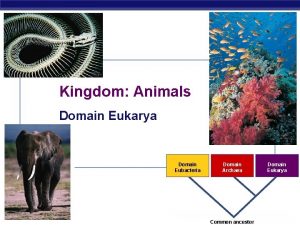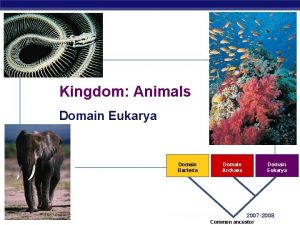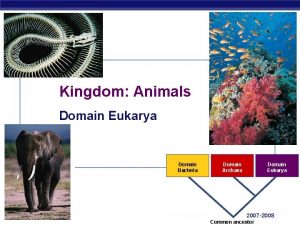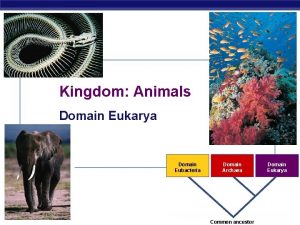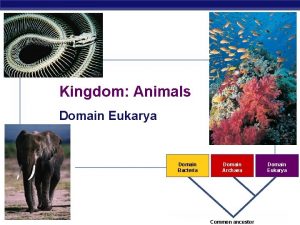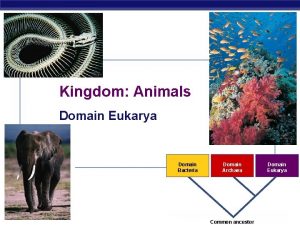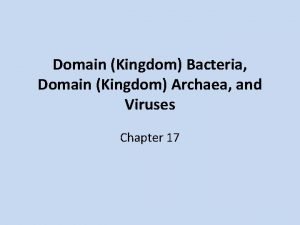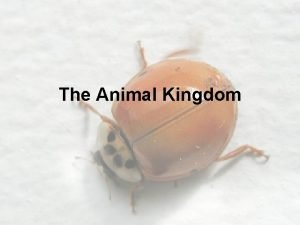Introduction to Animals Section 2 Animal Kingdom Domain























- Slides: 23

Introduction to Animals Section 2 – Animal Kingdom Domain Bacteria Domain Archaea Common ancestor Domain Eukarya

Introduction to Animals Section 2 – Animal Kingdom Domain Bacteria Domain Archaea Common ancestor Domain Eukarya

Animal Characteristics • Heterotrophs – must ingest others for nutrients • Multicellular – complex bodies • No cell walls – allows active movement • Sexual reproduction – no alternation of generations – no haploid gametophyte

Animal Evolution Cnidaria Porifera sponges jellyfish Nematoda Platyhelminthes Annelida Mollusca Echinoderm Arthropoda flatworms roundworms mollusks segmented worms insects spiders Chordata starfish vertebrates backbone segmentation endoskeleton coelom body cavity bilateral symmetry tissues multicellularity Ancestral Protist

Body Cavity How much is the digestive tract separated from the rest of the body? ectoderm mesoderm endoderm acoelomate ectoderm mesoderm endoderm pseudocoelomate pseudocoel § 3 GERM layers ectoderm u mesoderm u endoderm ectoderm mesoderm coelom cavity u coelomate endoderm

Invertebrate: Porifera • Sponges – Diploblastic (two germ layers) – no distinct tissues or organs • do have specialized cells – no symmetry – sessile (as adults) food taken into each cell by endocytosis

Invertebrate: Cnidaria • Jellyfish, hydra, sea anemone, coral – – Diploblastic (two germ layers) tissues, but no organs radial symmetry predators • tentacles surround gut opening • GASTROVASCULAR cavity • extracellular digestion – release enzymes into gut cavity

Invertebrate: Platyhelminthes • Flatworms – – – Triploblastic (3 germ layers) Acoelom Fluke, tapeworm, Planaria few parasitic bilaterally symmetrical • allows high level of specialization within parts of the body • Most have one opening (GASTROVASCULAR CAVITY) ectoderm mesoderm endoderm

Invertebrate: Nematoda • Roundworms – Triploblastic – Pseudocoelom – bilaterally symmetrical – have both mouth & anus • well-developed digestive system – many are parasitic • hookworm • pinworm

Invertebrate: Mollusca • Mollusks – clams, snails, squid – bilaterally symmetrical (with exceptions) – soft bodies, mostly protected by hard shells – true coelom

Invertebrate: Annelida • Segmented worms – earthworms, leeches – segments are not specialized – bilaterally symmetrical – true coelom fan worm leech

Invertebrate: Arthropoda • Spiders, insects, crustaceans – most successful animal phylum – bilaterally symmetrical – segmented • allows jointed appendages – exoskeleton • chitin + protein

Arthropod groups arachnids 8 legs, 2 body parts spiders, ticks, scorpions crustaceans gills, 2 pairs antennae crab, lobster, barnacles, shrimp insects 6 legs, 3 body parts

Invertebrate: Echinodermata • Starfish, sea urchins, sea cucumber – Adults - radially symmetrical – spiny exoskeleton – Water vascular system

Invertebrate quick check… Invertebrates: Porifera, Cnidaria, Platyhelminthes, Nematoda, Annelida, Mollusca, Arthropoda, Echinodermata • Which group includes snails, clams, and squid? • Which group is the sponges? • Which are the flatworms? …segmented worms? …roundworms? • Which group has jointed appendages & an exoskeleton? • Which two groups are radially symmetrical? • Which group has no symmetry?

Chordata • Vertebrates – fish, amphibians, reptiles, birds, mammals hollow dorsal nerve cord – internal bony skeleton becomes brain & spinal cord • backbone encasing spinal column • skull-encased brain becomes gills or Eustachian tube pharyngeal pouches postanal becomes tail or tailbone becomes vertebrae notochord

salmon, trout, sharks Vertebrates: Fish • Characteristics – body structure • bony OR cartilaginous skeleton • jaws & paired appendages (fins) • scales – body function • gills for gas exchange • two-chambered heart; single loop blood circulation • ectotherms – reproduction • external fertilization • external development in aquatic egg gills body

Vertebrates: Amphibian • Characteristics lung – body structure • legs (tetrapods) • moist skin – body function buccal cavity glottis closed • lungs (positive pressure) & diffusion through skin for gas exchange • three-chambered heart/2 loops • ectotherms – reproduction • external fertilization • external development in aquatic egg • metamorphosis (tadpole to adult) frogs salamanders toads

dinosaurs, turtles lizards, snakes alligators, crocodile Vertebrates: Reptiles • Characteristics – body structure • dry skin, scales, armor – body function • • • lungs for gas exchange thoracic breathing; negative pressure three-chambered heart/2 loops ectotherms excrete uric acid – reproduction leathery embryo shell • internal fertilization • external development in amniotic egg chorion allantois yolk sac amnio

finches, hawk ostrich, turkey Vertebrates: Birds • Characteristics – body structure • feathers & wings • thin, hollow bone; flight skeleton – body function • • very efficient lungs & air sacs four-chambered heart/2 loops endotherms excrete uric acid – reproduction trachea lung anterior air sacs • internal fertilization • external development in amniotic egg posterior air sacs

Vertebrates: Mammals mice, ferret elephants, bats whales, humans • Characteristics – body structure • hair • specialized teeth – body function muscles contract • lungs, diaphragm; negative pressure • four-chambered heart/2 loops • endotherms – reproduction • internal fertilization • internal development in uterus – nourishment through placenta • birth live young • mammary glands make milk diaphragm contracts

Vertebrates: Mammals • Sub-groups – monotremes • egg-laying mammals • duckbilled platypus, echidna – marsupials • pouched mammals • short-lived placenta • koala, kangaroo, opossum – placental • true placenta • shrews, bats, whales, humans

Vertebrate quick check… • • • Which vertebrates lay eggs with shells? Which vertebrates are covered with scales? What adaptations do birds have for flying? What kind of symmetry do all vertebrates have? Which vertebrates are ectothermic and which are endothermic • Why must amphibians live near water? • What reproductive adaptations made mammals very successful? • What characteristics distinguish the 3 sub-groups of mammals?
 Introduction to animals section 1 animal characteristics
Introduction to animals section 1 animal characteristics Section 26-1 introduction to the animal kingdom
Section 26-1 introduction to the animal kingdom Old kingdom middle kingdom new kingdom
Old kingdom middle kingdom new kingdom Old kingdom middle kingdom new kingdom
Old kingdom middle kingdom new kingdom Old kingdom middle kingdom new kingdom
Old kingdom middle kingdom new kingdom Capital of egypt during the old kingdom
Capital of egypt during the old kingdom Animal classification domain
Animal classification domain Domain animal kingdom
Domain animal kingdom Kyle douglass
Kyle douglass Are bears producers or consumers
Are bears producers or consumers Parasitic food chain example
Parasitic food chain example Carnivore
Carnivore Animal with no bones
Animal with no bones Characteristics of animal kingdom
Characteristics of animal kingdom Are protists eukaryotic
Are protists eukaryotic Plantae
Plantae Domain eukarya kingdom plantae
Domain eukarya kingdom plantae The odds and ends kingdom
The odds and ends kingdom All vertebrate animals are in domain
All vertebrate animals are in domain Bacteria grouping
Bacteria grouping Grasshopper phylum and class
Grasshopper phylum and class Euglena domain
Euglena domain Linnaeus
Linnaeus Domain vs kingdom
Domain vs kingdom
